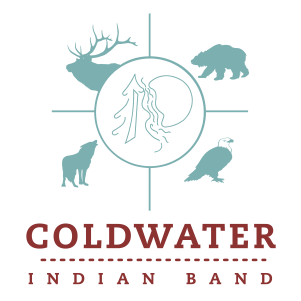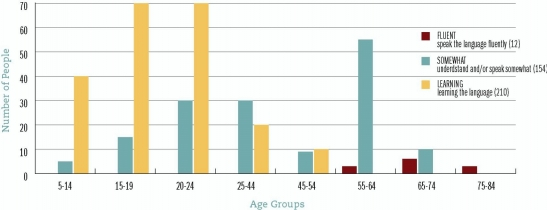We are Interior Salish people who belong to the Nlaka’pamux Nation. We are connected to other Nlaka’pamux communities through shared values, language and ancestry. Locally, our people are known as C’eletkwmx, and our regional affiliation is with the Scw’exmx, the “People of the Creeks.”

Our Nlaka’pamuxcin Language
The Nlaka’pamuxcin language is still spoken by a few of our Elders.
Our recent integration of the language into the Nc’tetkwu Band School curriculum is leading to a resurgence of interest and knowledge among our young people.
Currently we have 12 members that speak and understand our language fluently, and 154 that somewhat understand and/or speak our language. All those who speak and understand the language fluently are aged 55 and over, but fortunately 210 members are learning the language.
Nlaka’pamuxcin Language Fluency

Our Nlaka’pamux Territory
As a member of the Nlaka’pamux Nation, we have connections to the entire Nlaka’pamux territory, which spans a large region in the south central interior of British Columbia.
This territory stretches from the Fraser Canyon and Princeton in the south to Cache Creek and Kamloops in the north.
It borders the territory of the Okanagan, Sylix and Secwepemc peoples. We have a special connection to the Coldwater watershed and the cultural resources it has provided to our people for millennia.
The main Coldwater Reserve area (IR#1) is located approximately 13 km southwest of Merritt
Pauls Basin (IR#2) is located approximately 22km southwest of Merritt
Gwen Lake (IR#3) is located approximately 15km south of MerrittNlaka’pamux Traditional Territory

Our Nlaka’pamux History
Our Nlaka’pamux ancestors have used and occupied this area since time immemorial.
They travelled and settled far and wide across the territory that would become the southern interior of British Columbia and northern Washington State.
Rivers, valleys and mountain passes provided “highways” for our people to access the resources they needed to live a good and abundant life. They fished salmon in the rivers and streams, hunted game in the forests, mountains and grasslands, and gathered plants and medicines throughout the territory, all the while trading with neighbouring nations.
Our ancestors lived in pithouses during the winter months, and during the rest of the year, they travelled in family groups across the territory, accessing seasonal resources as they became available. Summer villages were special places where family groups came together to socialize, attend to governance matters, and to share, trade and gather resources. These Nlaka’pamux ancestors enjoyed a rich, complex cultural and spiritual life with teachings that structured social life and governance.
When European settlers arrived in Nlaka’pamux territory in the first half of the 19th century, our ancestors willingly entered into economic relationships with these new neighbours, while incorporating the new technologies and occupations they brought with them into our lives.
By the mid-19th century, the newcomer population had grown exponentially, which in turn resulted in many changes to daily life in Nlaka’pamux communities. Although our ancestors continued to engage in traditional activities on the land, accessing that land became more difficult as settlers put up fences and privatized large areas of our traditional territory.
In addition to continuing with their traditional activities, our ancestors adapted to this new way of life and the new rules and regulations about accessing lands and resources that were imposed by colonial governments. During this period, our ancestors took on new livelihoods such as ranching, farming and working on railroad construction. Today, agriculture and forestry continue to be popular among our members.








